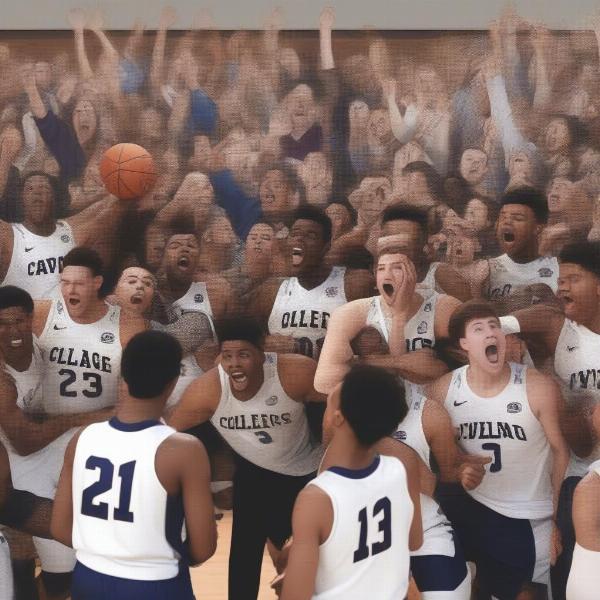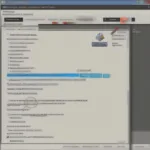A college basketball game’s length can vary, but understanding the rules and factors influencing game duration provides a clearer picture. This article dives into the specifics of college basketball game lengths, covering everything from regulation play to overtime periods and the impact of media timeouts.
Regulation Play and Overtime in College Basketball
A standard men’s college basketball game consists of two 20-minute halves, totaling 40 minutes of regulation play. Women’s college basketball, however, is played in four 10-minute quarters, also summing up to 40 minutes. If the score is tied at the end of regulation, overtime periods are played. Overtime in college basketball is 5 minutes long, regardless of gender. Multiple overtime periods are played until a winner is determined.
Factors Affecting College Basketball Game Length
Several factors contribute to the overall length of a college basketball game. Fouls, free throws, timeouts, and official reviews can all extend the game beyond the standard 40 minutes. Media timeouts, inserted for commercial breaks, also add to the total time. The pace of play, influenced by the teams’ strategies, can also significantly affect game length. A fast-paced game with fewer stoppages will naturally be shorter than a slower, more methodical game with numerous fouls and timeouts.
Media Timeouts and Their Impact
Media timeouts are pre-determined breaks in the game, typically occurring at specific points in each half or quarter. These timeouts allow for commercial breaks and are essential for broadcasters. While they contribute to the overall duration of the broadcast, they do not affect the actual game time itself. Understanding the distinction between game time and broadcast time is crucial when considering how long a college basketball game takes to watch.
The Role of Fouls and Free Throws
Fouls play a significant role in shaping the flow and duration of a college basketball game. Each foul results in a stoppage of play, and depending on the type of foul, free throws may be awarded. These free throws, while crucial for scoring, add extra time to the game. Strategic fouling, especially towards the end of a close game, can significantly extend the overall game length.
Understanding Game Time vs. Broadcast Time
It’s important to differentiate between game time and broadcast time. Game time refers to the actual 40 minutes of regulation play plus any overtime periods. Broadcast time, however, includes the game time plus media timeouts, halftime breaks, and pre-game and post-game analysis. A typical college basketball broadcast can last anywhere from two to three hours, significantly longer than the actual game time.
 College Basketball Game Going into Overtime
College Basketball Game Going into Overtime
Strategies and Pace of Play
The strategies employed by the teams involved can considerably influence a college basketball game’s length. A team that prefers a fast-paced, up-tempo offense will likely lead to a shorter game, while a team focusing on ball control and a slower, more deliberate offense can extend the game time. Defensive strategies, such as pressing or zone defenses, can also influence the game’s tempo and consequently its duration.
Halftime and Its Purpose
Halftime in college basketball serves as a break between the two halves or the second and third quarters, providing teams time to rest, strategize, and make adjustments. This break typically lasts around 15 minutes and contributes to the overall broadcast time.
Differences Between Men’s and Women’s Games
While both men’s and women’s college basketball games aim for a 40-minute regulation time, the structure differs. Men’s games use two 20-minute halves, while women’s games use four 10-minute quarters. This structural difference can impact the flow and feel of the game but generally doesn’t drastically alter the overall game length.
Conclusion
Understanding how long a college basketball game lasts involves considering several factors beyond the standard 40 minutes of regulation play. Overtime, fouls, timeouts, media breaks, and game strategies all contribute to the total duration. While the actual game time remains relatively consistent, the broadcast time can vary considerably. By considering these elements, you can gain a better appreciation for the dynamics influencing the length of a college basketball game.
FAQ
- How long is a regulation college basketball game? A regulation college basketball game is 40 minutes long, consisting of two 20-minute halves for men and four 10-minute quarters for women.
- How long is overtime in college basketball? Overtime periods in college basketball are 5 minutes long.
- What factors can make a college basketball game longer? Fouls, free throws, timeouts, official reviews, and media timeouts can all extend the length of a college basketball game.
- What’s the difference between game time and broadcast time? Game time is the actual playing time, while broadcast time includes game time plus halftime, media timeouts, and pre- and post-game coverage.
- How do media timeouts affect game length? Media timeouts add to the overall broadcast time but don’t affect the actual game time.
- Do men’s and women’s college basketball games have different lengths? Both men’s and women’s games have a 40-minute regulation time, but men play two halves while women play four quarters.
- How can game strategies impact the length of a college basketball game? Fast-paced offenses tend to lead to shorter games, while slower, more deliberate offenses can extend the game’s length.

